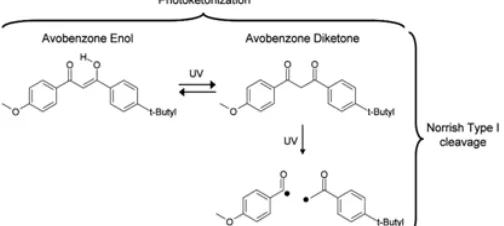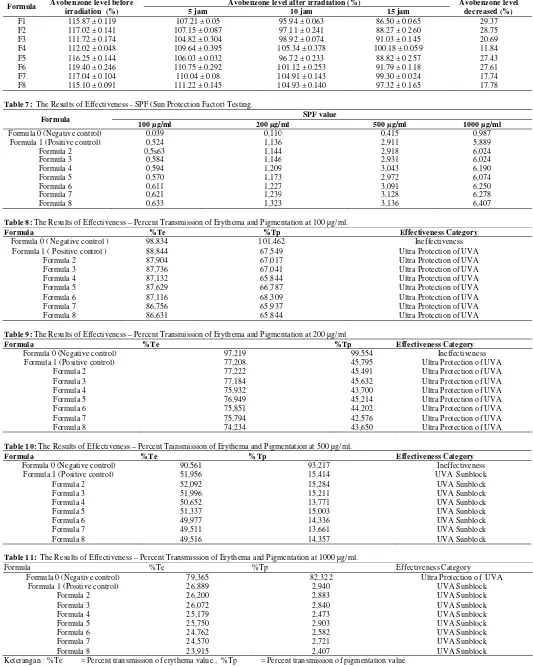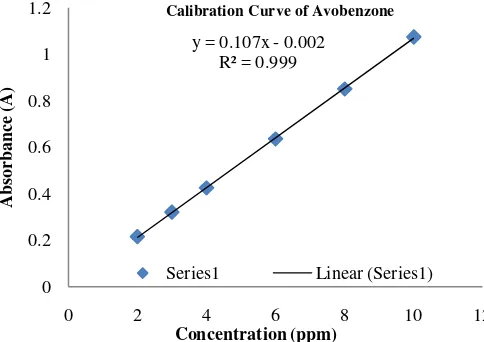© 2015 Marline Abdassah et al. This is an open access article distributed under the terms of the Creative Commons Attribution License -NonCommercial-ShareAlike Unported License (http://creativecommons.org/licenses/by-nc-sa/3.0/).
Journal of Applied Pharmaceutical Science Vol. 5 (06), pp. 070-074, June, 2015 Available online at http://www.japsonline.com
DOI: 10.7324/JAPS.2015.50611 ISSN 2231-3354
I n-vitro
Assessment of Effectiveness and Photostability Avobenzone in
Cream Formulations by Combination Ethyl Ascorbic acid and alpha
Tocopherol Acetate
Marline Abdassah, Ratih Aryani, Emma Surachman, Muchtaridi Muchtaridi*
Faculty of Pharmacy, Padjadjaran University, Sumedang, West Java, Indonesia.
ARTICLE INFO ABSTRACT
Article history: Received on: 22/03/2015 Revised on: 19/04/2015 Accepted on: 22/05/2015 Available online: 27/06/2015
Avobenzone is UVA sunscreen active substances, which are unstable when exposed to UV radiation, especially UVA. Theaim of this study is to determine the effectiveness and photo stability avobenzone when combined with ethyl ascorbic acid and alpha tocopherol acetate with various concentrations of ethyl ascorbic acid and alpha tocopherol by in vitro using spectrophotometric method. The photostability study of the eight variations of formula showed that the formula3, 4, 5, 6, 7 and 8 had significant differences with Formula 1 (p<0,05) and the best photostability represented by the formula 4 (avobenzone 2%, ethyl ascorbic acid2%) with avobenzone concentrations decrease by 11,82% for 15 hour using UVA lamp irradiation 4,7 mW/cm2. In effectiveness of SPF (Sun Protection Factor) value determination showed moderate protection category (SPF ±6). The percent transmission of erythema and pigmentation test showed that cream had effectiveness as sunscreen by showing the category as sun block on the area pigmentation and not to erythema areas at concentration 1000 µg/ml.
Key words:
UVA, SPF (Sun Protecting Factor), erythema transmission, pigmentation transmission.
INTRODUCTION
The sunlight that reaches the Earth’s surface is composed of ultraviolet (200-400 nm), visible (400-800 nm) and infrared (> 800 nm) radiation. Ultraviolet light emitted is divided into three regions, namely the UVC (200-290 nm), UVB (290-320 nm) and UVA I region (340-400 nm) and UVA II region (320-340 nm) (Gonzalez et al., 2007; Bonda and Marinelli, 1999; Chaudhuri et al., 2006). The skin need protect from ultraviolet radiation hazard. Sunscreen is one effort to minimize of ultraviolet radiation penetration into the skin. Indonesia is a tropical country where the sun exposure is high to require the preparation of cosmetics that acts as a sunscreen (WHO, 2013). The Environmental Working Group (EWG) that founded in 1993 by Ken Cook and Richard Wiles reviewed over 1800 sunscreens and more than 257 brands and found morethan75% of sunscreens contain toxic chemicals that can increase the risk of cancer and other health problems. Chemical sunscreens identified hazards
.
* Corresponding Author
Muchtaridi Muchtaridi, Department of Pharmaceutical Analysis and Medicinal Chemistry, Faculty of Pharmacy, Universitas Padjadjaran, Indonesia. Email: [email protected]
include PABA (Para amino benzoic acid), menthylanthranilate, oxybenzone, 4-metilbenzilidin camphor, 3-benzilidin camphor, Octylmethoxycinnamate, homosalate, octisalate, and octocrylene. FDA announced to use sunscreen safety and agreed that avobenzone can be used as chemical sunscreens(EWG’s, 2013). The good sunscreen should have photo-stability. Photostability is defined as the ability of a molecule to remain intact with irradiation filter or sunscreen(Gonzalez et al., 2007; Hojerova et
al., 2011), because they are deliberately selected as the molecules
that absorb UV radiation (Nash and Tanner, 2014).
Avobenzone is significantly degraded by UV radiation and sunlight thus the effectiveness is reduced in skin protection
(Rai et al., 2012; Beasley and Meyer, 2010). One hour of sunlight
The effectiveness of sun-screen preparations can be determined in-vitro by calculating the value of SPF (Sun Protection Factor), percent transmission of erythema (%Te) and percent transmission of pigmentation (%Tp) (Pelizzo et al., 2012; Gonzalez et al., 2007; Mishra and Chattopadhyay, 2012; Hupel et
al., 2011) .
Fig. 1: Photoketonization reaction (reversible) and Norrish Type I reaction (irreversible) of Avobenzone.
The aim of this study was to determine avobenzone photostability that combined with ethyl ascorbic acid and alpha-tocopherol acetate to assess avobenzone levels before and after UVA lamp exposure, and determine effectiveness include the SPF value, percent transmission of erythema and pigmentation.
MATERIALS AND METHOD
Chemicals
Avobenzone, ethyl ascorbic acid, alpha tocopherol acetate were purchased from Sigma (St Louis, USA), ethanol 96% (Merck), cream bases were purchased from local industry in Bandung, Indonesia.
Apparatus
The apparatus used included analytical balance (Sartorius), double beam Shimadzu UV/Visible spectro-photometer, UVA Lamp 4,7mW/cm2, UV radiometer, SPSS for window version 18.0, hot plate, homogenizer (IKA), rhion viscometer, pH strip (acid indicator), thermometer, centrifugation,
ultrasonic, and other glassware commonly used in the laboratory.
Stock Solution
20 mg avobenzone was weighed, transferred to a 100 ml volumetric flask, diluted to volume with ethanol 96% to give 200 µg/ml solution.
Maximum wavelength determination of avobenzone ( max) The maximum wavelength is determined at a concentration of 6 µg/ml of avobenzone diluted with ethanol 96%. The measurements were taken in the range of 200 to 400 nm
Preparation of Calibration Curve
Appropriate dilutions of the stock solution were done separately to get 2, 3, 4, 6, 8 and 10 µg/ml. The absorbances were
measured at 356 nm ( max of Avobenzone), and the calibration curves were plotted.
Cream Formulations
All of formulas was used for the preparation of oil-in-water creams containing F1 (basic as negatif control), F2 (avobenzone 2% as positive control), F3 (avobenzone 2% and ethyl ascorbic acid 0,5%), F4 (avobenzone 2% and ethyl ascorbic acid 1%), F5 (avobenzone 2% and ethyl ascorbic acid 2%), F6 (avobenzone 2%, ethyl ascorbic acid 0,5%, and alpatocopherolacetatate 1%), F7 (avobenzone 2%, ethyl ascorbic acid 1%, and alpha tocopherol acetate 1%), F8 (avobenzone 2%, ethyl ascorbic acid 2.0%, and alpha tocopherol acetate 1%).
Evaluation of Sunscreen Cream
Organoleptic observations
Organoleptic testing was done by looking at changes in color, odor (rancidity), and the occurrence of phase separation or rupture of cream.
Homogeneity test
Homogeneity testing was observed by checking the particles size between two object glasses to determine the formation of coarse particles.
pH Measurements
The pH measurements were carried out with pH strip acid indicator.
Viscosity Measurements
The viscosity cream measurements were carried out on rhion viscometer using spindle number 2 and the measurement were carried out in triplicate and calculated the average (Kumar, et
al., 2011).
Centrifuge test
Centrifuge testing has been done by centrifuging a cream preparation at a speed of 3800 rpm for 5 hour, and phase separation was observed (Lachman et al., 1994; Elya et al., 2013).
Thermal Stability
Cream preparation stored for 1 month at room temperature (28±2 °C), and checked every week include organoleptic, homogeneity, viscosity and pH (Lachman, et al.,
1994).
Photostability Testing of Sunscreen Cream
Sample Irradiation
time each formula is taken and stored in a place protected from sunlight (Venditti et al., 2008).
Initial Absorbance Measurements
Cream (0.1 g) was weighed, dissolved on 96% ethanol and the absorbances was measured by UV spectrophotometerat 356 nm. Avobenzone levels were calculated using the regression line equation of calibration curve.
Absorbance Measurements after UVA irradiation
A cream (0.1 g) were UVA irradiation dissolved in 96% ethanol and absorbance was measured with UV spectrophotometer at 356 nm ( max of Avobenzone), and avobenzone levels were calculated using the regression line equation of calibration curve.
Evaluation
The Data of photostability testing of avobenzone cream was performed between the level of avobenzone and length of exposure time to UV light and the significance of the differences between mean values (where p < 0.05) was analyzed by the block method of variance (ANAVA) from SPSS version 18.0.
Effectiveness Assessment of Sunscreen Cream SPF (Sun Protection Factor)
The cream (0.1 g) was weighed, further diluted in ethanol 96% to obtain 1000 µg/ml solution. The solution was diluted to obtain 100, 200, and 500 µg / ml. The absorption data were obtained in the range of 290-320 nm, every 5 nm. The SPF could be calculated followed by the application of Mandur equation (Gonzalez et al., 2007; Pelizzo et al., 2012; Sayre et al., 1980):
SPF spectr ophotomet r ic = EF(λ) x I(λ) x Abs(λ)
Where :CF = correction factor = 10; EE (λ) = erythemal effect spectrum; I (λ) = solar intensity spectrum; Abs = absorbance of sunscreen product. The values of EE (λ) x I (λ) are constants. It is determined by Sayre et al (1980).
Table 1: Normalized product function used in the calculation of SPF.
Wavelenght (λ nm) EE (λ) x I (λ) normalized regulations that categorize the effectiveness of sunscreen based on
SPF values (Diffey andRobson, 1989). In evaluating SPF, sample was treated at thickness of 2 mg/cm2, the SPF was calculated as the ratio of MED (Minimal Erythema Dose) of sunscreen-protected skin compare to the MED of unsunscreen-protected skin (Haywood
et al., 2003; Stephens et al., 2011).
Table 2: Prediction of SPF value.
SPF Protection Category
Percent Transmission of Erythema and Pigmentation
The cream (0.1 g) was weighed, dissolved in ethanol 96% to obtain 1000 µg/ml solution. The solution has been diluted into100, 200, and 500 µg / ml. The absorption data were obtained in the range of erythema and pigmentation wavelength 292,5-%Tp = percent transmission of pigmentation; Ee = Ʃ(%T x Fe); Ep = Ʃ(%T x Fp).
Table 3: Transmission of erythema.
Wavelength Range (nm) Erythema Fluks (Fe)
Table 4: Transmission of Pigmentation.
Wavelength Range (nm) Pigmentation Fluks (Fp)
Table 5: Rating Sunscreen Category.
%Te %Tp Sunscreen Category
Table 6: The results of measurement of cream absorbances before and after UVA irradiation
Formula Avobenzone level before
irradiation (%)
Avobenzone level after irradiation (%) Avobenzone level
decreased (%)
5 jam 10 jam 15 jam
F1 115.87 ± 0.119 107.21 ± 0.05 95.94 ± 0.063 86.50 ± 0.065 29.37
F2 117.02 ± 0.141 107.15 ± 0.087 97.11 ± 0.241 88.27 ± 0.260 28.75
F3 111.72 ± 0.174 104.82 ± 0.304 98.92 ± 0.074 91.03 ± 0.145 20.69
F4 112.02 ± 0.048 109.64 ± 0.395 105.34 ± 0.378 100.18 ± 0.059 11.84
F5 116.25 ± 0.144 106.03 ± 0.032 96.72 ± 0.233 88.82 ± 0.257 27.43
F6 119.40 ± 0.246 110.75 ± 0.292 101.12 ± 0.253 91.79 ± 0.118 27.61
F7 117.04 ± 0.104 110.04 ± 0.08 104.91 ± 0.143 99.30 ± 0.024 17.74
F8 115.10 ± 0.091 111.22 ± 0.145 104.93 ± 0.140 97.32 ± 0.165 17.78
Table 7: The Results of Effectiveness - SPF (Sun Protection Factor) Testing.
Formula SPF value
100 µg/ml 200 µg/ml 500 µg/ml 1000 µg/ml
Formula 0 (Negative control) 0,039 0,110 0,415 0,987
Formula 1 (Positive control) 0,524 1,136 2,911 5,889
Formula 2 0,5s63 1,144 2,918 6,024
Formula 3 0,584 1,146 2,931 6,024
Formula 4 0,594 1,209 3,043 6,190
Formula 5 0,570 1,173 2,972 6,074
Formula 6 0,611 1,227 3,091 6,250
Formula 7 0,621 1,239 3,128 6,278
Formula 8 0,633 1,323 3,136 6,407
Table 8: The Results of Effectiveness – Percent Transmission of Erythema and Pigmentation at 100 µg/ml.
Formula %Te %Tp Effectiveness Category
Formula 0 ( Negative control ) 98,834 101,462 Ineffectiveness
Formula 1 ( Positive control ) 88,844 67,549 Ultra Protection of UVA
Formula 2 87,904 67,017 Ultra Protection of UVA
Formula 3 87,736 67,041 Ultra Protection of UVA
Formula 4 87,132 65,844 Ultra Protection of UVA
Formula 5 87,629 66,787 Ultra Protection of UVA
Formula 6 87,116 68,309 Ultra Protection of UVA
Formula 7 86,756 65,937 Ultra Protection of UVA
Formula 8 86,631 65,844 Ultra Protection of UVA
Table 9: The Results of Effectiveness – Percent Transmission of Erythema and Pigmentation at 200 µg/ml
Formula %Te %Tp Effectiveness Category
Formula 0 (Negative control) 97,219 99,554 Ineffectiveness
Formula 1 (Positive control) 77,208 45,795 Ultra Protection of UVA
Formula 2 77,222 45,491 Ultra Protection of UVA
Formula 3 77,184 45,632 Ultra Protection of UVA
Formula 4 75,932 43,700 Ultra Protection of UVA
Formula 5 76,949 45,214 Ultra Protection of UVA
Formula 6 75,851 44,202 Ultra Protection of UVA
Formula 7 75,794 42,576 Ultra Protection of UVA
Formula 8 74,234 43,650 Ultra Protection of UVA
Table 10: The Results of Effectiveness – Percent Transmission of Erythema and Pigmentation at 500 µg/ml.
Formula %Te %Tp Effectiveness Category
Formula 0 (Negative control) 90,561 93,217 Ineffectiveness
Formula 1 (Positive control) 51,956 15,414 UVA Sunblock
Formula 2 52,092 15,284 UVA Sunblock
Formula 3 51,996 15,211 UVA Sunblock
Formula 4 50,652 13,771 UVA Sunblock
Formula 5 51,337 15,003 UVA Sunblock
Formula 6 49,977 14,336 UVA Sunblock
Formula 7 49,511 13,661 UVA Sunblock
Formula 8 49,516 14,357 UVA Sunblock
Table 11: The Results of Effectiveness – Percent Transmission of Erythema and Pigmentation at 1000 µg/ml.
Formula %Te %Tp Effectiveness Category
Formula 0 (Negative control) 79,365 82,322 Ultra Protection of UVA
Formula 1 (Positive control) 26,889 2,940 UVA Sunblock
Formula 2 26,200 2,883 UVA Sunblock
Formula 3 26,072 2,840 UVA Sunblock
Formula 4 25,179 2,473 UVA Sunblock
Formula 5 25,750 2,903 UVA Sunblock
Formula 6 24,762 2,582 UVA Sunblock
Formula 7 24,570 2,721 UVA Sunblock
Formula 8 23,915 2,407 UVA Sunblock
Fig. 2: Calibration Curve of Avobenzone ( 356 nm).
CONCLUSIONS
The results of analysis of variance showed that the addition of ethyl ascorbic acid and alpha tocopherol acetate in cream formula gave the significant difference photostability with the formula 1 (avobenzone 2%) with 95% confidence level (p≤0,05).The formula 4 (avobenzone 2% and 2% ethyl ascorbic acid) was the best formula to stabilize avobenzone in preparation. The addition of ethyl ascorbic acid and alpha tocopherol acetate might improved the SPF value, but have been not able to improve the effectiveness of protection against erythema/UVB. While, the value of percent transmission of erythema (Te) and percent transmission of pigmentation (Tp) decreased.
REFERENCES
Afonso, S., Horita, K., Sousa e Silva, J. P., Almeida, I. F., Amaral, M. H., Lobao, P. A., Costa, P. C., Miranda, M. S., Esteves da Silva, J. C., and Sousa Lobo, J. M. Photodegradation of avobenzone: stabilization effect of antioxidants. J Photochem Photobiol B, 2014; 140:36-40.
Agustin, R., Yulida, O., and Henny, L. Formulasi Krim Tabir Surya Dari Kombinasi Etil p-Metoksisinamat dengan Katekin. In Seminar Nasional Perkembangan Terkini Sains Farmasi dan Klinik III, 2013; 184-198. sunscreen photostability. Paris: 46 - 51.
Chaudhuri, R., Lascu, Z., Puccetti, G., Deshpande, A., and Paknikar, S. Design of a photostabilizer having built-in antioxidant functionality and its utility in obtaining broad-spectrum sunscreen formulations. Photochem Photobiol, 2006; 82:823 - 828.
Diffey, B., and J. Robson. A new substrate to measure sunscreen protection factors throughout the ultraviolet spectrum. J Soc Cosmet Chem, 1989; 40:127-133.
EWG’s. Cosmetics Database. 2013. [cited. Available from http://www.ewg.org/skindeep/ingredient/700596/AVOBENZONE/.
Gonzalez, H., Tarras-Wahlberg, N., Stromdahl, B., Juzeniene, A., Moan, J., Larko, O., Rosen, A., and Wennberg, A.-M.
Photostability of commercial sunscreens upon sun exposure and irradiation by ultraviolet lamps. BMC Dermatology, 2007; 7 (1):1.
Haywood, R., Wardman, P., Sanders, R., and Linge, C. Sunscreens inadequately protect against ultraviolet-A-induced free radicals in skin: implications for skin aging and melanoma? J Invest Dermatol, 2003; 121 (4):862-868.
Hojerova, J., Medovcikova, A., and Mikula, M. Photoprotective efficacy and photostability of fifteen sunscreen products having the same label SPF subjected to natural sunlight. Int J Pharm, 2011; 408 (1-2):27-38.
Hupel, M., Poupart, N., and Gall, E. A. Development of a new in vitro method to evaluate the photoprotective sunscreen activity of plant extracts against high UV-B radiation. Talanta, 2011; 86:362-371.
Korac, R. R., and Khambholja, K. M. Potential of herbs in skin protection from ultraviolet radiation. Pharmacogn Rev, 2011; 5 (10):164-173.
L'Alloret, F., Candau, D., Seite, S., Pygmalion, M. J., Ruiz, L., Josso, M., Meaudre, H., Gauchet, L., Pena, A. M., and Colonna, A. New combination of ultraviolet absorbers in an oily emollient increases sunscreen efficacy and photostability. Dermatol Ther (Heidelb), 2012; 2 (1):4.
Latha, M. S., Martis, J., Shobha, V., Sham Shinde, R., Bangera, S., Krishnankutty, B., Bellary, S., Varughese, S., Rao, P., and Naveen Kumar, B. R. Sunscreening agents: a review. J Clin Aesthet Dermatol, 2013; 6 (1):16-26.
Mishra, A., and Chattopadhyay, P. Assessment of In vitro Sun Protection Factor of Calendula Officinalis L. (Asteraceae) Essential Oil Formulation. J Young Pharm, 2012; 4 (1):17-21.
Miura, Y., Takiguchi, Y., Shirao, M., Takata, S., Yanagida, T., Fukui, H., Naganuma, M., and Hatao, M. Algorithm for in vitro Sun Protection Factor based on transmission spectrum measurement with concomitant evaluation of photostability. Photochem Photobiol, 2008; 84 (6):1569-1575.
Nash, J. F., and Tanner, P. R. Relevance of UV filter/sunscreen product photostability to human safety. Photodermatol Photoimmunol Photomed, 2014; 30 (2-3):88-95.
Pelizzo, M., Zattra, E., Nicolosi, P., Peserico, A., Garoli, D., and Alaibac, M., 2012, In vitro evaluation of sunscreens: an update for the clinicians. ISRN Dermatol, 2012:352135.
Rai, R., Shanmuga, S. C., and Srinivas, C. Update on photoprotection. Indian J Dermatol, 2012; 57 (5):335-342.
Sayre, M. R., Patricia Poh Agin, Deborah L. Desrochers, and Marlowe, E. Sunscreen testing method s: In vitro predictions of effectiveness. Soc Cosm Chem, 1980; 31:133-143.
Stephens, T. J., Herndon, J. H., Jr., Colon, L. E., and Gottschalk, R. W. The impact of natural sunlight exposure on the UVB-sun protection factor (UVB-SPF) and UVA protection factor (UVA-PF) of a UVA/UVB SPF 50 sunscreen. J Drugs Dermatol, 2011; 10 (2):150-155.
Sugihartni, N., Marchaban, Pramono, dan Suwidiyo. Pengaruh Penambahan Fraksi etanol dari Infusa daun Plantago mayor L. Terhadap Efektivitas Oktil Metoksisinamat Sebagai Bahan Aktif Tabir Surya. Majalah Farmasi Indonesia, 2005; 16 (3):130-135.
Venditti, E., Spadoni, T., Tiano, L., Astolfi, P., Greci, L., Littarru, G. P., and Damiani, E. In vitro photostability and photoprotection studies of a novel 'multi-active' UV-absorber. Free Radic Biol Med, 2008; 45 (3):345-354.
WHO. 2003, Sun Protection A Primary Teaching Resouce. France : WHO. World Health Organization 2013 [cited 03/22/2015 2003]. Available from http://www.who.int/uv/publications/en/primaryteach.pdf.



